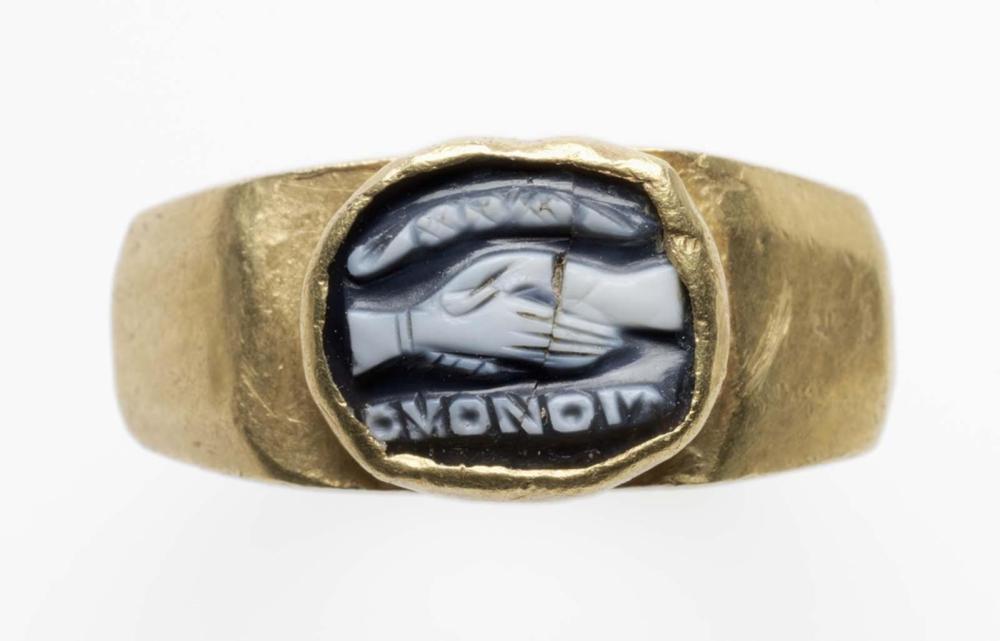Advanced Search 

Ring with cameo of clasped hands
Roman, Eastern Mediterranean
Imperial Period
3rd century A.D.
Medium/Technique
Gold and sardonyx
Dimensions
Height x width x depth: 1 x 2.3 x 1.9 cm (3/8 x 7/8 x 3/4 in.)
Credit Line
Gift of Robert E. Hecht, Jr. in memory of Robert E. Hecht, Sr. and Julia K. Hecht
Accession Number63.1555
NOT ON VIEW
CollectionsEurope, Jewelry, Ancient Greece and Rome
ClassificationsJewelry / Adornment – Rings
Romans, and later Christians, recognized the clasping of right hands as a pledge of faith, used to ac-knowledge consent in both political and personal exchanges and contracts, including marriage. Here the gesture appears on a cameo bezel, carved from blue-and-white sardonyx and set into an octagonal gold ring. The bracelet adorning the wrist of the hand on the left indicates that it belongs to a woman; the hand on the right, without jewelry, is presumably male. The paired hands are framed by a garland of flowers above and the Greek word omonoia (harmony) below.
The association of the word omonoia with marriage may relate to the frequent appearance of the equivalent Latin word, concordia, on Roman coins of the second and third centuries A.D. that celebrate imperial couples; on some of these coins, the goddess Concordia herself is represented as a guardian of marriage, safeguarding both the union of the imperial couple and the hopes of all Romans for universal harmony. Here, the use of the Greek word, rather than the Latin, indicates that this ring was made in one of the Greek-speaking Roman provinces of the eastern Mediterranean, perhaps Asia Minor or Syria. The cameo was a popular form of jewelry in the early third century, and the octagonal ring shape is also typical of this date. While few known cameos share this clasped-hands design, gold and silver rings bearing similar images in relief on their bezels suggest that such rings were widely worn by married couples.
The association of the word omonoia with marriage may relate to the frequent appearance of the equivalent Latin word, concordia, on Roman coins of the second and third centuries A.D. that celebrate imperial couples; on some of these coins, the goddess Concordia herself is represented as a guardian of marriage, safeguarding both the union of the imperial couple and the hopes of all Romans for universal harmony. Here, the use of the Greek word, rather than the Latin, indicates that this ring was made in one of the Greek-speaking Roman provinces of the eastern Mediterranean, perhaps Asia Minor or Syria. The cameo was a popular form of jewelry in the early third century, and the octagonal ring shape is also typical of this date. While few known cameos share this clasped-hands design, gold and silver rings bearing similar images in relief on their bezels suggest that such rings were widely worn by married couples.
Catalogue Raisonné
Highlights: Classical Art (MFA), p. 094.
DescriptionA traditional Roman marriage ring with bezel design of two clasped hands. The woman's hand on the left wears a bracelet. Above, a garland or fillet. Below, OMONOIA, "harmony" (white on blue background). Octagonal hoop with oval bezel mounting. The shape of the ring suggests that it was worn on the upper joints of fingers rather than lower as indicated by figural sculptures wearing jewelry.
ProvenanceBy date unknown: with Robert E. Hecht, Jr.; October 17, 1963: gift to MFA in memory of R. E. and Julia K. Hecht
